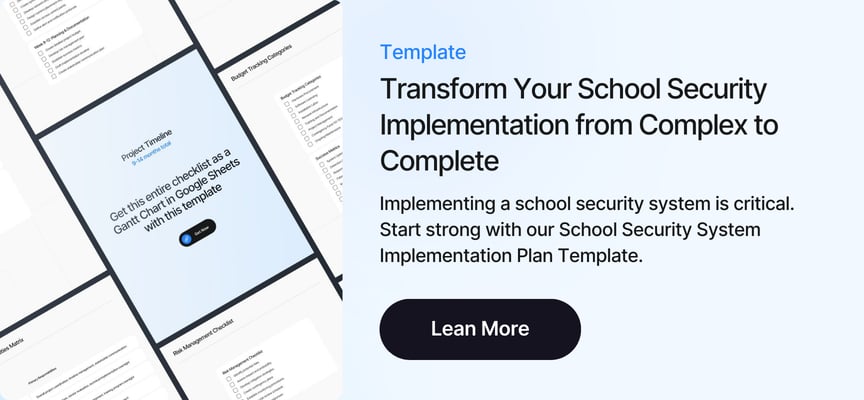Key Points
- Comprehensive student safety in schools requires addressing physical security, emotional wellbeing, and digital protection as interconnected elements that work together to create secure learning environments
- Modern AI-powered security systems can detect weapons, medical emergencies, and behavioral incidents in real-time, enabling proactive intervention before situations escalate
- Effective school safety programs balance robust security measures with positive school climate initiatives that support student mental health and foster inclusive communities
- Digital safety education and cyberbullying prevention are essential components of modern student protection strategies that extend beyond traditional physical security measures
- Successful implementation requires collaboration between administrators, security professionals, educators, and families to create comprehensive safety ecosystems that protect students holistically
What is Student Safety in Schools?
Student safety in schools encompasses a comprehensive approach that protects students physically, emotionally, and digitally while preserving the nurturing environment essential for learning and growth. It represents far more than installing security cameras or conducting lockdown drills; it's about creating environments where students feel secure enough to focus on academics, build relationships, and develop into confident individuals.
Today's educational leaders face unprecedented challenges in ensuring student safety in schools. The complexity of modern safety concerns requires sophisticated solutions that address multiple threat vectors simultaneously, from physical security breaches to cyberbullying incidents.
Read the full school safety guide.
The Multi-Dimensional Nature of Student Safety in Schools
Physical Security: The Foundation of Student Protection
Physical safety forms the cornerstone of any comprehensive student safety in schools strategy. This dimension addresses immediate threats to student wellbeing, from unauthorized access to medical emergencies and potential violence.
Modern school safety measures extend beyond traditional approaches like locked doors and visitor badges. Advanced AI-powered security systems now provide continuous monitoring capabilities that human observers simply cannot match. These systems can detect weapons even when partially concealed, identify medical emergencies like seizures or falls, and recognize developing conflicts before they escalate into serious incidents.
According to data from the National Center for Education Statistics, 67% of schools reported at least one violent incident during the 2021-2022 school year, highlighting the critical need for proactive security measures.
Core Physical Security Elements for Schools:
- Perimeter Control: Monitoring and managing all entry points with intelligent access systems that distinguish between authorized and unauthorized individuals
- Real-Time Threat Detection: AI-powered video intelligence that identifies weapons, suspicious behavior, and potential dangers as they develop
- Medical Emergency Response: Immediate identification of health crises, falls, and medical distress situations requiring rapid intervention
- Incident Prevention: Early detection of fights, bullying, and aggressive behaviors before they escalate into serious confrontations
- Emergency Communication: Instant notification systems that connect security teams, administrators, and first responders during critical situations
Emotional and Psychological Wellbeing in Schools
Student safety in schools encompasses emotional security, which directly impacts academic performance and personal development. Students who feel emotionally safe are more likely to engage in learning, form positive relationships, and report concerns when they arise.
Creating emotionally safe school environments requires addressing bullying, promoting inclusive practices, and providing mental health support. Research shows that approximately 20% of students aged 12-18 reported being bullied at school, demonstrating the ongoing need for comprehensive anti-bullying initiatives.
Essential Emotional Safety Components:
- Anti-Bullying Programs: Comprehensive policies and education initiatives that prevent harassment and promote respectful interactions
- Mental Health Support: Access to counselors, social workers, and crisis intervention specialists who can address student emotional needs
- Inclusive Environment Creation: Programs that celebrate diversity and ensure all students feel valued and accepted regardless of background
- Peer Support Systems: Student-led initiatives that foster community and provide platforms for students to support one another
- Crisis Intervention Protocols: Trained staff and clear procedures for addressing mental health emergencies and emotional distress situations
Digital Safety and Cybersecurity for Students
Modern student safety in schools extends into digital spaces where students spend increasing amounts of time. Digital safety encompasses protection from cyberbullying, online predators, inappropriate content, and privacy violations.
Educational institutions must balance providing access to digital learning tools while protecting students from online threats. Studies indicate that approximately 15% of high school students report being electronically bullied, making digital safety education crucial.
Technology's Role in Comprehensive Student Safety
AI-Powered School Security Intelligence
Advanced artificial intelligence transforms traditional security cameras into intelligent monitoring systems that never tire, never look away, and never miss critical details. These AI-powered school safety software systems analyze video feeds in real-time, identifying potential threats and anomalies that require immediate attention.
VOLT AI's platform exemplifies this technological evolution in student safety in schools. The system processes feeds from existing security cameras, eliminating the need for expensive hardware replacements while dramatically enhancing detection capabilities.
AI Security Capabilities for Student Safety:
Detection Type | Traditional Monitoring | AI-Powered Systems | Student Safety Impact |
Manual observation | Real-time automated detection | Seconds vs. minutes response | |
Medical Emergencies | Reactive discovery | Immediate alert generation | 15-second response capability |
Behavioral Incidents | Post-incident investigation | Proactive intervention | Prevention vs. reaction |
Coverage Area | Limited human capacity | 100% camera monitoring | Complete facility oversight |
Alert Accuracy | Variable human attention | Consistent AI validation | Reduced false alarms |
Integration with Existing School Infrastructure
Effective school safety technology solutions work seamlessly with current security infrastructure rather than requiring complete system overhauls. Modern AI platforms integrate with existing IP cameras, access control systems, and communication networks to enhance rather than replace current investments.
This integration approach allows educational institutions to achieve advanced student safety in schools capabilities while maintaining budget considerations and minimizing operational disruption. Systems like VOLT AI's platform can be operational within 24 hours for cloud deployments, providing immediate security enhancements.
Building Comprehensive Student Safety Ecosystems
Collaborative School Safety Planning
Successful student safety in schools initiatives require collaboration among multiple stakeholders, each contributing unique expertise and perspectives. Administrators provide policy guidance, security professionals offer threat assessment capabilities, educators contribute behavioral insights, and families provide community support.
This collaborative approach ensures safety measures address real concerns while maintaining the positive school climate essential for effective education. Regular communication and feedback loops help refine safety strategies based on evolving needs and emerging threats. Building a culture of safety requires this comprehensive stakeholder engagement.
Balancing Security and Learning Environment
Educational leaders must navigate the delicate balance between robust security measures and maintaining welcoming, nurturing learning environments. Students need to feel protected without feeling restricted or surveilled in ways that hinder their educational experience.
Modern student safety in schools solutions help achieve this balance through privacy-conscious monitoring that focuses on behaviors and threats rather than individual identification. AI systems can track concerning activities while protecting student privacy through advanced anonymization techniques. This approach to school safety and security maintains educational effectiveness while enhancing protection.
Implementation Strategies for School Safety Leaders
Phased Deployment Approach for Student Safety
Successful student safety in schools system implementation follows a structured approach that builds capabilities progressively while allowing for staff training and community adaptation. This phased strategy minimizes disruption while maximizing security benefits.
School Safety Implementation Phases:
- Phase 1: Assessment and Planning: Comprehensive facility evaluation, stakeholder consultation, and system design development
- Phase 2: Core Security Infrastructure: Installation of primary detection systems, staff training, and initial protocol establishment
- Phase 3: Enhanced Capabilities: Addition of advanced features, integration with emergency services, and community engagement programs
- Phase 4: Optimization and Expansion: System refinement based on operational experience and extension to additional areas or capabilities
Staff Training and Community Engagement
Technology alone cannot create safe schools. Human expertise, proper training, and community buy-in are essential for maximizing security system effectiveness and ensuring sustainable improvements to student safety in schools.
Training programs must address both technical system operation and emergency response procedures. Staff members need to understand how to interpret alerts, coordinate responses, and maintain communication during critical situations. The role of school safety officers becomes increasingly important in this technology-enhanced environment.
Measuring Student Safety Program Effectiveness
Key Performance Indicators for School Safety
Effective student safety in schools programs require measurable outcomes that demonstrate progress and identify areas for improvement. These metrics should encompass both quantitative data and qualitative assessments of school climate and student wellbeing.
Student Safety Program Metrics:
- Response Time Measurements: Time from incident detection to first responder arrival or intervention initiation
- Incident Prevention Rates: Number of potential situations identified and resolved before escalation
- System Reliability Statistics: Uptime percentages, false alarm rates, and detection accuracy measurements
- Community Confidence Surveys: Student, parent, and staff feedback on safety perceptions and program effectiveness
- Academic Performance Correlation: Analysis of learning outcomes in relation to safety program implementation
Continuous Improvement Processes
Student safety in schools programs must evolve continuously to address emerging threats and incorporate lessons learned from operational experience. Regular program reviews, stakeholder feedback collection, and system updates ensure sustained effectiveness.
This improvement process includes analyzing incident data, updating response protocols, and incorporating new technologies as they become available. Educational institutions should view safety as an ongoing commitment rather than a one-time implementation. Comprehensive safety plans require this continuous refinement approach.
The Future of Student Safety in Schools
Emerging Technologies and Capabilities
Technological advancement continues to expand possibilities for student protection. Emerging capabilities include enhanced behavioral analysis, improved threat prediction, and more sophisticated integration with emergency response systems.
These developments promise even more effective protection while maintaining the balance between security and educational environment quality. Future systems will likely offer greater customization, improved accuracy, and enhanced privacy protection for student safety in schools.
Partnership in Protection
Creating truly safe schools requires recognizing that technology serves as a force multiplier for human expertise rather than a replacement for it. The most effective student safety in schools programs combine advanced AI capabilities with dedicated professionals who understand both security principles and educational environments.
VOLT AI's approach exemplifies this partnership philosophy, providing sophisticated detection capabilities while maintaining human validation of alerts through our Security Operations Center. This combination ensures rapid response to genuine threats while minimizing false alarms that could disrupt the learning environment.
Educational leaders who prioritize comprehensive student safety in schools create environments where learning flourishes, communities thrive, and students develop the confidence to reach their full potential. The investment in comprehensive safety measures pays dividends in academic achievement, student wellbeing, and community trust. Understanding why school safety is important helps guide these critical decisions that protect our most valuable asset, our students.





